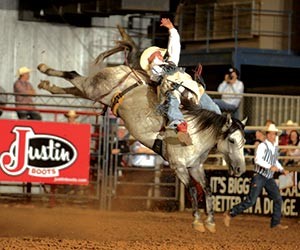Surrounding the major metros, smaller Lone Star cities form no mere supporting cast, but stand as pillars with their own significant strengths as meetings destinations.
Made in the Metroplex
Anchored by its Six Flags Over Texas amusement park for 51 years, Arlington also boasts Cowboys Stadium, the world’s largest domed sporting and event center, and the meetings-capable Rangers Ballpark. With the Arlington Convention Center centered in the action, the CVB has rebranded and changed its name to Experience Arlington, reflecting its status as a global sports and entertainment draw.
“We are capitalizing on our visibility as a sports destination to attract top corporate, state and regional associations,” says Jay Burress, president and CEO of the Arlington CVB. “The message is that Arlington offers experiences you cannot find anywhere else.”
Recently implementing a Certified Tourism Ambassador Program, Arlington just opened the new 218,000-square-foot University of Texas at Arlington College Park Event Center, which can accommodate large-scale events. Heritage tourism is also a focus, with assets like the beguiling Top O’ Hill Terrace, a legendary haunt once known as “Las Vegas before Las Vegas.”
Home to DFW International, one of the world’s largest airports, Grapevine continues to grow its hospitality opportunities for planners, conferees and leisure travelers.
“By offering affordable, convenient facilities located just five minutes from the airport, groups choosing Grapevine are able to select first-rate accommodations with on-site meeting space,” says Bruce Dalton, director of sales for the Grapevine CVB. “With personalized services including guidance on special events venues, partner programs, entertainment, temporary staffing, transportation and much more, we are able to save planners time and money in these challenging economic times.”
With 18 properties all within 10 minutes of DFW Airport, Grapevine offers 800,000 square feet of space and more than 11,000 rooms within 15 minutes of its historic downtown area. With visitor draws including top-ranked public golf courses, a thriving wine industry and the Grapevine Vintage Railroad, the city impressively welcomes more than 13.5 million business and leisure travelers each year.
Immediately adjacent to DFW International Airport, hotel-rich Irving is a development trendsetter.
“With new convention center development unheard of in this recessionary environment, our new $133 million Irving Convention Center at Las Colinas has significantly strengthened the city’s high-end business appeal,” says Maura Gast, executive director of the Irving CVB. “The city’s leadership understands the importance of an attached hotel and walkable dining and entertainment options for long-term convention center success, so eventual additional phases will include a performance venue, hotel and entertainment complex.”
Now connecting downtown Dallas to the Irving Convention Center, the Dallas Area Rapid Transit’s Orange Line will extend from the center to DFW Airport by 2013, bringing mass transit to the transit hub for the first time.
Irving’s ROI? Repeat customers, according to Gast.
“Our customer service program brings clients back year after year,” she says.
Just 20 minutes from both DFW and Love Field airports, Frisco continues to shine as a versatile option in the Metroplex. With key assets including the second-largest ballroom in Texas, Dr Pepper Arena and the 330-room Embassy Suites, attached to the Frisco Conference Center, Frisco lives up to its “Texas’ Rising Star” tagline.
With the city primarily drawing corporate, state association, religious and sporting groups, the Frisco CVB is enhancing its marketing approach with a new mobile-compatible website and photo-intensive meetings microsite.
Frisco is also promoting its family vacation appeal.
“We offer 8 million square feet of shopping and dining options, arts and culture, recreation and professional sports, and other accessible, low-cost activities that everyone can enjoy,” says Marla Roe, executive director of the Frisco CVB. “That type of appeal goes far, and we’re seeing more attendees bring their families and plan vacation time around their gatherings.”
Home to Southfork Ranch, now back in the spotlight with the return of the Dallas TV show and among the region’s most highly sought after off-site venues, the corporate community of Plano has evolved with the times.
“Over the past few years, we have learned to work smarter and invest our time and assets for optimal return,” says Mark Thompson, executive director of the Plano CVB. “Plano is best known for helping our corporate partners to stretch their dollars during these economic times.”
Investing significantly in developing its social media program, the CVB is also enhancing its Group Assistance Program (GAP).
“This program is designed to attract first-time events to Plano by providing them with grant funds to help underwrite some of their expenses,” Thompson says.
Tightening its belt due to the economy, Mesquite, celebrating its 125th birthday this year, is also focusing on integrating social media in its marketing efforts, along with technology upgrades. The Mesquite Convention Center and Exhibit Hall have beefed up broadband Internet capabilities throughout, heightening their high-tech appeal to DFW area groups.
Home of the long-running Mesquite Pro Rodeo, the adjacent Mesquite Arena remains the city’s main draw. Planners can incorporate a private rodeo or enjoy a regularly scheduled rodeo at the celebrated venue, which also hosts trade associations, religious meetings, dog shows and other gatherings.
“We want planners to choose our affordable options because it makes the most sense for them,” says Judy Skowron, director of the Mesquite CVB. “Our tailored services will more than meet their requirements for meeting space, rooms, spouse tours, conference planning and anything in between.”
Houston Hubs
According to Pam Summers, president of the Bay Area Houston CVB, the economic downturn has presented a unique opportunity for this lively bayside region, nestled midway between Houston and Galveston, to shine in the meetings market.
“Corporate and other groups seeking budget-conscious alternatives can still plan fun, successful meetings in our area,” Summers says. “We offer abundant hotel rooms, waterfront resorts included, along with attractions such as the Kemah Boardwalk and Space Center Houston, team building, and dining, shopping and golf.”
Summers highlights the expansion of Hobby Airport (and Ellington Airport, also close-by) to include international routes as a real plus for the area, which encompasses seven distinct cities touching some 35 miles of waterfront.
“Our member cities and attractions are constantly developing new ways to attract groups and meetings, including streamlining transportation and parking, installing better wayfinding signs, and updating their facilities and infrastructure,” she says.
To Houston’s north, The Woodlands felt few recessionary bumps, and this relaxing locale is enhancing its premier position in the Texas meetings market. Home to perennial favorite The Woodlands Resort & Conference Center, featuring 60,000 square feet of IACC-approved space, this inviting city has seen an influx of restaurants, wine bars and entertainment spots ideal for conferees.
Formerly known as Water Taxis, six newly renovated Waterway Cruisers are a great option for exploring the roughly 1.6-mile Woodlands Waterway corridor, with private catered charters available for up to 20 guests. Also home to Woodlands Waterway Marriott Hotel & Convention Center, featuring 70,000 square feet of meeting and event space, the Woodlands’ biggest selling points are location and accessibility.
“The Woodlands offers planners a centralized location without the headaches associated with meeting in a busy, traffic-filled urban center,” says Nick Wolda, president of the Woodlands CVB. “Our proximity to Bush Intercontinental Airport allows groups to start their itinerary on the day of arrival.”
Located an hour north of Houston on scenic Lake Conroe, the ever-evolving, amenity-rich La Torretta Lake Resort & Spa has it all, including 73,000 square feet of IACC-certified meeting space.
The Hills Are Alive
With Austin and San Antonio included in its expansive reach, centrally located Texas Hill Country, featuring local charmers like Fredericksburg, New Braunfels and Boerne, encompasses dynamic smaller locales for groups.
Best known as the “Sports Capital of Texas,” Round Rock was ranked the nation’s fourth-best-performing city for 2011 by the Milken Institute, alongside neighboring Austin. (San Antonio was first.) As the headquarters of Dell and heavy with other tech employers, including Apple, Samsung and Facebook, Round Rock registered strongly with the annual Milken index, which looks closest at employment growth in giving its ranking.
“Round Rock has continued to thrive during the recession,” says Nancy Yawn, director of the Round Rock CVB. “To enhance our position in the sporting event market, we recently decided to invest $12 million in a state-of-the-art sports complex, which is due to open in late 2013.”
With stellar facilities, year-round sun and comfortable hotels, the city is ideal for youth and amateur sporting events.
“On or off the playing field, we offer a unique sports destination experience visitors will be sure to remember,” Yawn says.
East of Austin and triangulated with San Antonio and Houston, Bryan-College Station, home of Texas A&M, is also focusing on sports marketing to offset recessionary impact on its traditional association bookings.
“To counter declining attendance and competition from first-tier cities offering discounted rates, we are building up other markets, including sports, social and medical,” says Shannon Overby, executive director of the Bryan-College Station CVB.
Offering red carpet, hands-on customer service, the CVB’s new “It Pay$ to Check Us Out!” incentive program offers double bottom-line benefit.
“More than 80 percent of the population of Texas lives within a 180-mile radius of Bryan-College Station, which favors higher attendance rates,” Overby says. “With abundant amenities including free hotel parking and complimentary Wi-Fi at most properties, we also save you money.”
Attracting many Texas-based associations to its central location between Austin and San Antonio on Interstate 35 (and shoppers to its hugely popular outlets), San Marcos fared well during the downturn.
“Prior to 2008, we did not have a conference facility,” says Rebecca Ybarra-Ramirez, executive director of the San Marcos CVB. “Since opening in October 2008, Embassy Suites San Marcos Hotel, Spa and Conference Center’s group sales have surpassed year-on-year goals by as much as 20 percent.”
Much of this growth can be attributed to servicing and support from the CVB and hotel, including media and transportation assistance, bags and welcome tables, area coupons and welcome dignitary scheduling.
“We also coordinate with Embassy Suites staff on bid presentations, initial meetings and site visits,” Ybarra-Ramirez says. “Our primary goal is repeat business and continuing our track record of boosting registrations and participation, in turn increasing profit for the client.”






